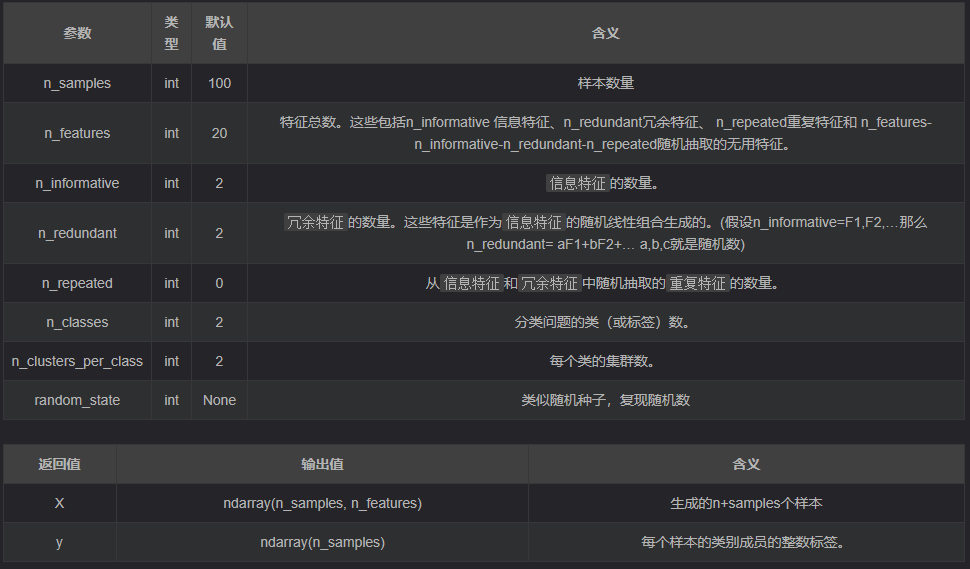make_classification函数
sklearn.datasets.make_classification
1 | sklearn.datasets.make_classification(n_samples=100, n_features=20, *, n_informative=2, n_redundant=2, n_repeated=0, n_classes=2, n_clusters_per_class=2, weights=None, flip_y=0.01, class_sep=1.0, hypercube=True, shift=0.0, scale=1.0, shuffle=True, random_state=None) |

生成一个随机的 n nn 类分类问题。
在不打乱的情况下,X按以下顺序水平堆叠特征:主要n_informative特征,然后n_redundant 是信息特征的线性组合,然后是n_repeated 重复,随机抽取信息和冗余特征的替换。其余特征充满随机噪声。因此,无需改组,所有有用的特征都包含在列中 。X[:, :n_informative + n_redundant + n_repeated]
1 2 3 4 5 6 7 8 9 10 11 12 13 14 15 16 17 18 19 20 21 22 | from sklearn.datasets import make_classificationX, y = make_classification(n_samples=6, n_classes=2, n_features=5, n_informative=5,n_redundant=0,n_clusters_per_class=1)display(X,y)"""n_samples=6 - 6行6个数据n_classes=2 - 结果分为2类即二分类n_features=5 - 5个特征n_informative=5 - 5个全部有效的特征n_redundant=0 - 冗余特征为0n_clusters_per_class=1 - 每一个类别聚为一个簇array([[ 1.10885456, -1.97464085, 2.14372944, -0.08241471, -2.60173628], [ 0.98456921, -4.67257395, -0.10161149, 0.52329866, 2.0178222 ], [-2.92441307, -2.20249011, 0.12827954, 1.90711152, 0.24340137], [ 0.14524134, -1.42685331, 1.92731161, -0.72915701, 1.3529692 ], [-0.09694719, -0.28604481, -2.62609999, -0.46131174, 0.72515074], [ 0.25540393, -2.64589841, -2.05721611, 0.53203936, 0.34273113]]) array([0, 1, 1, 0, 1, 0])""" |
同时参考这链接中的不平衡数据部分,以及代码部分的crossvalidate()
1 2 3 4 5 6 7 8 9 10 11 12 13 14 15 16 17 18 19 20 21 22 23 | from sklearn.ensemble import RandomForestClassifierfrom sklearn.model_selection import cross_validateclassifier = RandomForestClassifier() scores = cross_validate( classifier, X, y, cv=10, scoring=['accuracy', 'precision', 'recall', 'f1','r2', 'neg_mean_squared_error'])scores = pd.DataFrame(scores)scores.mean()#outputfit_time 0.296672score_time 0.011580test_accuracy 0.911000test_precision 0.920261test_recall 0.904000test_f1 0.910236test_r2 0.644000test_neg_mean_squared_error -0.089000dtype: float64 |





【推荐】国内首个AI IDE,深度理解中文开发场景,立即下载体验Trae
【推荐】编程新体验,更懂你的AI,立即体验豆包MarsCode编程助手
【推荐】抖音旗下AI助手豆包,你的智能百科全书,全免费不限次数
【推荐】轻量又高性能的 SSH 工具 IShell:AI 加持,快人一步
· TypeScript + Deepseek 打造卜卦网站:技术与玄学的结合
· Manus的开源复刻OpenManus初探
· 写一个简单的SQL生成工具
· AI 智能体引爆开源社区「GitHub 热点速览」
· C#/.NET/.NET Core技术前沿周刊 | 第 29 期(2025年3.1-3.9)